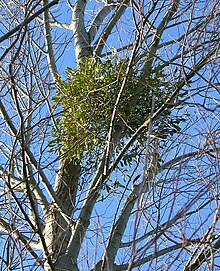
Back ተቀጥላ Amharic পরগাছা Bengali/Bangla Uchelwydd Welsh Muérdago Spanish دارواش Persian Drualus Irish דבקון HE Kapasilan ID ヤドリギ類 Japanese 겨우살이류 Korean


Mistletoe is the common name for obligate hemiparasitic plants in the order Santalales. They are attached to their host tree or shrub by a structure called the haustorium, through which they extract water and nutrients from the host plant. There are hundreds of species which mostly live in tropical regions.
The name mistletoe originally referred to the species Viscum album (European mistletoe, of the family Santalaceae in the order Santalales); it is the only species native to the British Isles and much of Europe. A related species with red fruits, rather than white, Viscum cruciatum, occurs in Southwest Spain and Southern Portugal, as well as in Morocco in North Africa and in southern Africa.[1] There is also a wide variety of species in Australia.[2] The genus Viscum is not native to North America, but Viscum album was introduced to Northern California in 1900.[3][4]
The eastern mistletoe native to North America, Phoradendron leucarpum, belongs to a distinct genus of the family Santalaceae.
European mistletoe has smooth-edged, oval, evergreen leaves borne in pairs along the woody stem, and waxy, white berries that it bears in clusters of two to six. The eastern mistletoe of North America is similar, but has shorter, broader leaves and longer clusters of ten or more berries.
Over the centuries, the term mistletoe has been broadened to include many other species of parasitic plants with similar habits, found in other parts of the world, that are classified in different genera and families such as the Misodendraceae of South America and the mainly southern hemisphere tropical Loranthaceae.
- ^ Cite error: The named reference
POWOwas invoked but never defined (see the help page). - ^ "Australian Mistletoes: unwrapping the mysteries of these intriguing native plants (CISRO)". 2 December 2019.
- ^ USDA, NRCS. 2009. The PLANTS Database (http://plants.usda.gov, 28 August 2009). National Plant Data Center, Baton Rouge, LA 70874-4490 US
- ^ F. G. Hawksworth and R. F. Scharpf (1986), "Spread of European mistletoe (Viscum album) in California, U.S.A." European Journal of Forest Pathology 16(1):1-6